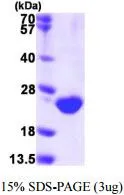
3 microg of GTX66975-pro Human DUSP3 protein (active) by SDS-PAGE under reducing condition and visualized by coomassie blue stain
Human DUSP3 protein, His tag (active)
GTX66975-PRO
Product group Molecular Biology
Overview
- SupplierGeneTex
- Product NameHuman DUSP3 protein (active)
- Delivery Days Customer9
- Application Supplier NoteSpecific activity is > 1000 units/mg, and is defined as the amount of enzyme that hydrolyze 1.0 nmoles of p-nitrophenyl phosphate (pNPP) per minute at pH 7.5 at 37C.
- ApplicationsFunctional Assay
- CertificationResearch Use Only
- Concentration1 mg/ml
- ConjugateUnconjugated
- Scientific DescriptionThe protein encoded by this gene is a member of the dual specificity protein phosphatase subfamily. These phosphatases inactivate their target kinases by dephosphorylating both the phosphoserine/threonine and phosphotyrosine residues. They negatively regulate members of the mitogen-activated protein (MAP) kinase superfamily (MAPK/ERK, SAPK/JNK, p38), which are associated with cellular proliferation and differentiation. Different members of the family of dual specificity phosphatases show distinct substrate specificities for various MAP kinases, different tissue distribution and subcellular localization, and different modes of inducibility of their expression by extracellular stimuli. This gene maps in a region that contains the BRCA1 locus which confers susceptibility to breast and ovarian cancer. Although DUSP3 is expressed in both breast and ovarian tissues, mutation screening in breast cancer pedigrees and in sporadic tumors was negative, leading to the conclusion that this gene is not BRCA1. [provided by RefSeq, Jul 2008]
- Storage Instruction-20°C or -80°C,2°C to 8°C
- UNSPSC12352204
